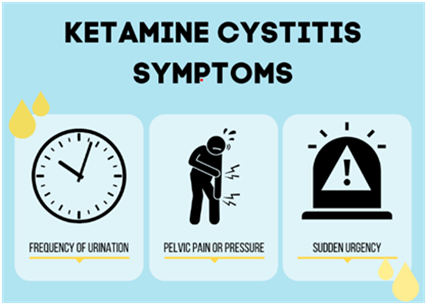(All references under Resources and Links)
Ketamine is an anaesthetic drug, currently classified as Class B by the ACMD although this is currently under review1. Between 2010 and 2020, its recreational use in those aged 16-24 doubled. A 2023 Scottish Government report 3 found that – of over 7,000 interviewed – one in ten S4 students reported taking ‘illegal drugs’ in the last month, and of those, ketamine was used by 35%.
Ketamine comes in either liquid form or as a crystallised white powder and is most commonly snorted. It can also be swallowed, mixed into a drink, wrapped in a cigarette paper (‘bombed’) or put into a gel capsule. It can be injected into a muscle, or it can be rectally administered (‘boofing’). When snorted, the onset is 5 minutes, and the effect lasts up to around 90 minutes depending on dose. However, the average is often a lot shorter and leads to a strong urge to re-dose for similar effects. It is cheaper than cocaine and may sell for as little as £20 a gram (a typical snorted dose is 30-75mg).
It produces feelings of relaxation, detachment and euphoria. Individuals that take ketamine report less of a comedown or hangover the next day than with alcohol, cocaine or cannabis, often waking up refreshed after a good sleep. Some report taking it to self-medicate for anxiety or depression. Higher doses can be hallucinogenic or cause dissociation.
Potential Complications
Ketamine in high dose, and particularly in combination with other drugs, can lead to overdose and death.
Ketamine use can affect balance and coordination and cause numbness and reduce the sensation of pain. It therefore increases the risk of accidents and injuries, or awareness of the extent of injuries, potentially fatal, and should not be used in unsafe places e.g. near open water, open windows and balconies.
At higher doses, people may describe an out of body experience called a ‘k hole’. A ‘k hole’ is the complete detachment or dissociation from surroundings. People k-holing may be non-verbal, unresponsive to communication, unable to move and have impaired memory. Affected individuals are therefore at risk of exploitation by others. Their pupils will be dilated and unable to focus. However, after about 60 – 90 minutes, the episode resolves, and the person returns to normal. It is important to advise that they avoid re-dosing for a while as the k-hole may resume.
Over time, people build up a tolerance to the drug and need to take more for a similar effect. People report withdrawal symptoms including cravings, low mood, anxiety, irritability and abdominal pain.
Long term use may lead to mental health problems such as depression, suicidal ideation or psychosis and can have a detrimental effect on memory.
Damage to the urinary tract and the liver
Ketamine is metabolised by the liver and excreted by the kidneys.
In a recent study of ketamine use disorder4:
- 60% had experienced bladder problems
- 56% reported K-cramps – a painful organ cramping linked to excessive use which can itself drive drug use for pain relief
- There can be liver damage with biliary dilatation and deranged Liver Function Tests (LFTs)
- There can be epigastric pain with gastritis, peptic ulcers or gastroduodenal erosions.
These liver symptoms can present before the urological ones so abnormal LFTs may be an early warning sign.
Repeated use can lead to serious urinary tract problems. Metabolites may cause inflammation of the urothelium which can lead to bladder fibrosis, and, in time, ketamine associated uropathy – bladder failure, hydronephrosis and kidney failure. People may present with ketamine cystitis – haematuria, dysuria, frequency, nocturia and incontinence. All these are only reversible in the early stages and users may be left with long-term disability due to bladder dysfunction (chronic urinary incontinence) or renal failure due to bladder outflow obstruction. There may also be abdominal, flank or pelvic pain, weight loss and sexual dysfunction. The incidence of these conditions is increasing with the rise in ketamine use and time lag to presentation.
Management
It is important to be aware of the possibility of ketamine use and ask about it especially in those under 30 presenting with lower urinary tract symptoms or sexual dysfunction. People may present to their GP, community pharmacist or other healthcare professionals.
Community pharmacists should be vigilant to subtle signs of chronic ketamine misuse particularly with young people who present with recurrent urinary problems or with deteriorating mental health, memory loss or minor injuries. Pharmacy First – NHS Lothian
Any staff working with ketamine users should proactively enquire about bladder symptoms.

Approaches include:
1. Harm Reduction Advice. Comprehensive and pragmatic advice is available at https://www.crew.scot/drug/ketamine/
2. The only way to reliably reduce the risk of severe long term bladder damage is to reduce the amount and frequency of use and hopefully stop altogether. This needs to happen as soon as possible to prevent, or limit, irreversible damage.People can be referred to local third sector organisations or CREW for information and support to stop. (See local HSCP or ADP websites for details).
3. Multidisciplinary management is crucial. If ketamine misuse is suspected or confirmed by community pharmacists, third sector workers or others, patients should be referred to their GP.
Medical Management
There is a LOW THRESHOLD for referral. Urological assessment includes assessing for high pressure bladder which can cause hydronephrosis and, untreated, lead to irreversible loss of kidney function. Specialist investigations include cystoscopy, bladder hydrodistension and urodynamic assessment of bladder function.
In some cases, when bladder capacity has been irreversibly damaged, urinary diversion of some form may be necessary.
Investigation and Treatment of Ketamine Uropathy
PLEASE NOTE THE LOW THRESHOLD FOR REFERRAL
The British Association of Urological Surgeons (BAUS) has produced a consensus statement in 2024 on the treatment of ketamine uropathy5 which provides clear and concise guidance:
- Urine dipstick, MSU, FBC, renal function, LFTs
- Symptom alleviation:
- Consider NSAIDs (though gastritis / renal risks)
- Alleviate constipation – laxatives can help.
- OAB or incontinence – trial of anticholinergic or b3 agonist like mirabegron.
Who to refer:
Due to the expected high rate of urological complications related to ketamine use, refer patients as urgent if they have:
- recurrent UTIs (symptomatic or proven on MSUs )
- bladder pain
- symptoms of Overactive Bladder and/or new incontinence.
How to refer:
By Sci Gateway to Urology at WGH
Please provide updated U & Es on referral and, if possible, organise an urgent urinary tract ultrasound. Ensure all symptoms are mentioned especially the following which may result in the referral being treated as even more urgent:
- upper tract dilation on ultrasound
- abnormal U & Es
- visible haematuria in the absence of confirmed UTI.













